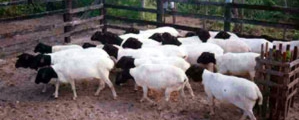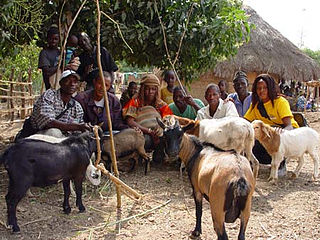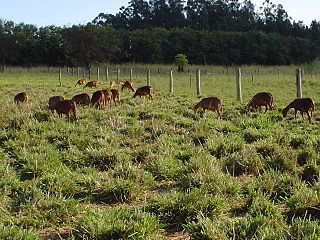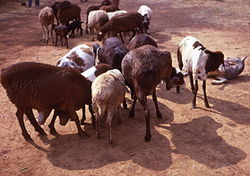
The Maasai are a Nilotic ethnic group inhabiting northern, central and southern Kenya and northern Tanzania, near the African Great Lakes region. The Maasai speak the Maa language, a member of the Nilotic language family that is related to the Dinka, Kalenjin and Nuer languages. Except for some elders living in rural areas, most Maasai people speak the official languages of Kenya and Tanzania, Swahili and English.

Haemonchus contortus, also known as the barber's pole worm, is a very common parasite and one of the most pathogenic nematodes of ruminants. Adult worms attach to abomasal mucosa and feed on the blood. This parasite is responsible for anemia, oedema, and death of infected sheep and goats, mainly during summer in warm, humid climates.

The Somali sheep, Somali language: Ido Soomaali occasionally known as the Somali Blackhead sheep, is a hair sheep native to Somalia, Djibouti, Ethiopia, Kenya.

The St Croix is a breed of domestic sheep native to the U.S. Virgin Islands and named for the island of Saint Croix. They are often also called Virgin Island White because those that were imported into North America were selected for white coloration. On the Island of St. Croix, they come in shades of brown, white, and black.

The Blackhead Persian is a fat-tailed breed of domestic sheep from Africa. The sheep is originally from Somalia and a direct descendant of the Somali sheep. The breed is also a type of hair sheep, meaning they do not grow wool and tolerate heat better than wooled breeds and are raised primarily for meat. The Blackhead Persian has a white body and, as their name would suggest, an entirely black head.

N'Dama is a breed of cattle from West Africa. Other names for them include Boenca or Boyenca (Guinea-Bissau), Fouta Jallon, Djallonké or Djallonké cattle, Fouta Longhorn, Fouta Malinke, Futa, Malinke, Mandingo (Liberia), and N'Dama Petite (Senegal). Originating in the Guinea highlands, they are also found in southern Senegal, Guinea-Bissau, the Gambia, Mali, Ivory Coast, Liberia, Nigeria, and Sierra Leone. They are trypanotolerant, allowing them to be kept in tsetse fly-infested areas. They also show superior resistance to ticks and the diseases they carry and to Haemonchus contortus stomach worms.

The West African Dwarf is a large and variable breed or group of breeds of domestic goat from coastal West and Central Africa, a range extending approximately from Senegal to Congo. It is characterised by achondroplasia or dwarfism, a trait that may have evolved in response to conditions in the humid forests of the area, and also by some degree of resistance to tsetse-borne trypanosomiasis or "sleeping-sickness".

Morada Nova is a Brazilian breed of domestic sheep. It originates in the state of Ceará, in Nordeste, the north-eastern region of Brazil, on the Atlantic coast.
The West African Dwarf or Djallonké is an African breed or group of breeds of domestic sheep. It is the dominant breed of West and Central Africa. This breed is primarily raised for meat. The Cameroon or Cameroon Dwarf is a breed within this group.

The Cameroon or Cameroon Dwarf is a Cameroonian breed of domestic sheep. It belongs to the West African Dwarf group of breeds. Some have been exported to Europe.
The Van Rooy, also known as the Van Rooy White Persian, is a breed of domestic sheep native to South Africa. The Van Rooy was first developed in 1906 by J. C. van Rooy, a South African Senator and farmer in the Bethulie district. The Van Rooy is cross between indigenous Ronderib Afrikaner sheep, and Rambouillets. It is a fat-tailed sheep and also a hair sheep, removing the need for shearing and crutching. They are generally kept for meat production, and are very well-suited to arid climates. Van Rooys are polled, have drooping ears, and are entirely white. The breed is relatively rare, even in South Africa, but has also been exported to Namibia and Zimbabwe.

Agriculture in Sierra Leone is a significant part of the economy of Sierra Leone, with it accounting for 58 percent national Gross Domestic Product (GDP) in 2007. Two-thirds of the population of Sierra Leone are involved in subsistence agriculture.

The Australian White (AUW) sheep breed, originating from Australia, is known for its coarse wool and specialization in mutton production. This breed combines genetic traits from four distinct sheep breeds: Dorper, Van Rooy, Polled Dorset, and Texel. AUW sheep offer advantages such as strong stress resistance, rapid growth, and are low-maintenance animals. With applications in both meat and wool production, AUW sheep present an opportunity for crossbreeding with local sheep varieties, aiming to enhance meat quality and boost production efficiency

The Gulf Coast Native is a breed of sheep found in the U.S. states bordering the Gulf Coast. Also occasionally known as the Louisiana Scrub, Pineywoods Native or simply Gulf Coast sheep, the breed is a mix of many of the sheep varieties brought to the Southern United States during the European colonization of the region. It is now an exceedingly rare breed, but one valuable for its ability to adapt to the hot humid climate of the Gulf Coast.

Teladorsagia circumcincta is a nematode that is one of the most important parasites of sheep and goats. It was previously known as Ostertagia circumcincta and is colloquially known as the brown stomach worm. It is common in cool, temperate areas, such as south-eastern and south-western Australia and the United Kingdom. There is considerable variation among lambs and kids in susceptibility to infection. Much of the variation is genetic and influences the immune response. The parasite induces a type I hypersensitivity response which is responsible for the relative protein deficiency which is characteristic of severely infected animals. There are mechanistic mathematical models which can predict the course of infection. There are a variety of ways to control the infection and a combination of control measures is likely to provide the most effective and sustainable control.
The Zulu sheep breed is native to South Africa and is predominantly raised by rural farmers in the province of KwaZulu-Natal. It serves primarily as a source of food and income to poor resource farmers. It belongs to the Nguni type of sheep together with the Pedi and the Swazi sheep.

FAMACHA is a selective treatment method for controlling the level of parasitic barber's pole worm among domesticated small ruminant populations. In contrast with earlier, more aggressive approaches, under FAMACHA only certain sheep or goats in a flock are selected for treatment. Selection for treatment is based on the degree of anaemia the animals are displaying in their mucous membranes, which is assessed through a colour guided chart.

Jafarabadi buffalo, Jaffrabadi buffalo or Gir buffalo is a riverine buffalo that originated in Gujarat, India. It is estimated that there are about 25,000 Jafarabadi buffaloes in the world. It is one of the important buffalo breeds of India and Pakistan. The Jafarabadi buffalo is also the first buffalo breed exported to Brazil, and is also one of the four buffalo breeds raised in Brazil as of 2017, the others being Mediterranean, Murrah and swamp buffalo.
The Afrino is a breed of sheep originating from South Africa. It was developed by crossing Ronderib Afrikaner sheep with Merino and South African Mutton Merino (SAMM) sheep, and is classified as a Merino breed.
A trypanotolerant organism is one which is relatively less affected by trypanosome infestation.















